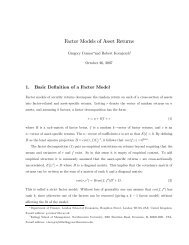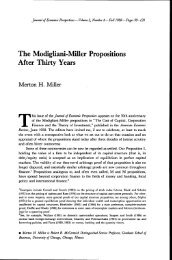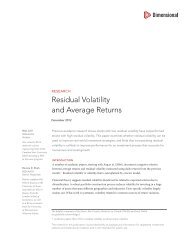Campbell, John Y, Jens Hilscher and Jan Szilagyi, 2005.
Campbell, John Y, Jens Hilscher and Jan Szilagyi, 2005.
Campbell, John Y, Jens Hilscher and Jan Szilagyi, 2005.
Create successful ePaper yourself
Turn your PDF publications into a flip-book with our unique Google optimized e-Paper software.
3.1 Forecasting at long horizonsAt the one month horizon our best specification captures about 30% of the variation inbankruptcy risk. We now ask what happens as we try to predict bankruptcies furtherinto the future. In Table 4 we estimate the conditional probability of bankruptcyin six months, one, two <strong>and</strong> three years. We again assume a logit specification butallow the coefficients on the variables to vary with the horizon of the prediction. Inparticular we assume that the probability of bankruptcy in j months, conditional onsurvival in the dataset for j − 1 months, is given byP t−1 (Y i,t−1+j =1| Y i,t−2+j =0)=11+exp ¡ −α j − β j x i,t−1¢. (4)Note that this assumption does not imply a cumulative probability of bankruptcythat is logit. If the probability of bankruptcy in j months did not change with thehorizon j, thatisifα j = α <strong>and</strong> β j = β, <strong>and</strong>iffirms exited the dataset only throughbankruptcy, then the cumulative probability of bankruptcy over the next j periodswould be given by 1 − (exp (−α − βx i ) /(1 + exp (−α − βx i )) j , which no longer hasthe logit form. Variation in the parameters with the horizon j, <strong>and</strong>exitfromthedataset through mergers <strong>and</strong> acquisitions, only make this problem worse. In principlewe could compute the cumulative probability of bankruptcy by estimating models foreach horizon j <strong>and</strong> integrating appropriately; or by using our one-period model <strong>and</strong>making auxiliary assumptions about the time-series evolution of the predictor variablesin the manner of Duffie <strong>and</strong> Wang (2003). We do not pursue these possibilitieshere, concentrating instead on the conditional probabilities of default at particulardates in the future.As the horizon increases in Table 4, the coefficients, significance levels, <strong>and</strong> overallfit of the logit regression decline as one would expect. Even at three years, however,almost all the variables remain statistically significant.Three predictor variables are particularly important at long horizons. The coefficient<strong>and</strong> t statistic on volatility SIGMA are almost unchanged as the horizonincreases; the coefficient <strong>and</strong> t statistic on the market-to-book ratio MB increase withthehorizon;<strong>and</strong>thecoefficient on relative market capitalization RSIZE switches sign,becoming increasingly significant with the expected negative sign as the horizon increases.These variables, market capitalization, market-to-book ratio, <strong>and</strong> volatility,are persistent attributes of a firm that become increasingly important measures of13





